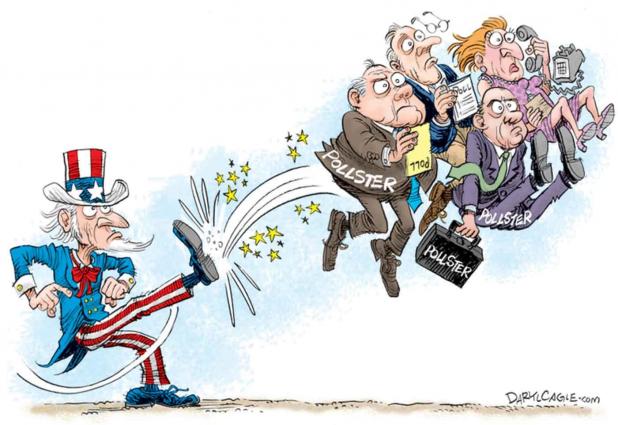
From the Editor: What else are opinion polls wrong about?
Do you feel the polls conducted before the presidential election were a) a sinister plot by an anti-Trump cabal b) a sinister plot by an anti-Biden cabal or c) irrelevant going forward because the polls were so far off you’ll never believe a poll again?
The race between President Donald Trump and former Vice President Joe Biden was close. The polls were not close to accurate. And that has implications that go even beyond picking the person who gets the nuclear codes.
Statistical sampling in one form or another has a role to play in the products that get made, how they’re packaged and marketed, figuring out how the economy is doing, determining what stores will be opened in what locations, and a thousand other aspects of our collective and individual lives.
When it came to the biggest polling challenge of them all, the presidential race, the pros let us down.
They got a bad rap in 2016, when the consensus was that Hillary Clinton would beat Trump. Trump won, but the polls weren’t that far off.
The Real Clear Politics website lists more than 30 national polls conducted just before the 2016 election. The median edge for Clinton was a shade over two points, and that’s about the amount by which she won the popular vote.
The state polls weren’t as close, but even there, many of them showed races within the margin of error, especially in key states such as Wisconsin and Pennsylvania. TV talking heads couldn’t resist anointing Clinton as the leader based on an advantage smaller than the margin of error.
You can’t do that. That’s what margin of error means.
This year? Holy moly.
In Pennsylvania, for example, Biden had a lead of about 48,000 votes, or 7/10ths of a point, as of Tuesday. On Nov. 2, the day before the election, NBC had Biden up by five points. CNBC had him up by four. Monmouth said Biden led by seven.
Even Trafalgar, the generally conservative organization that got credit for being more accurate than the mainstream guys Nov. 3, had Trump winning by two.
Quinnipiac had Biden winning by five and Reuters/Ipsos by four in Florida, the president’s biggest swing state victory. Trafalgar did better, saying Trump was ahead by five.
In a reverse of 2016, the national polls were off by bigger margins. Quinnipiac, for instance, picked Biden by 11 points, and the Economist/YouGov poll had Biden ahead by 10.
The actual Biden victory margin, if it turns out to be a victory margin, is about three points.
So what happened?
Looking at the basics of polling might offer some clues. For the poll’s results to be accurate, everyone in the group being represented has to have an equal chance of being questioned. Only a tiny group will be sampled, but the respondents have to be chosen at random.
A lack of true randomness may have been responsible for American history’s other big polling blunder, the 1948 presidential election. Polling made Republican Thomas Dewey the odds-on favorite over incumbent Harry S. Truman. But Truman won.
The polls were largely conducted by telephone. Who didn’t have phones in their homes in 1948? Blue-collar people, farmers, other rural people, especially rural southern people, recent immigrants and minorities.
That was the Democratic base. Truman’s support was underreported.
Assuming the sampling is right, the margin of error is calculated by dividing 1 by the square root of the sample size. In English, that means about 1,000 respondents are needed to get the margin of error down to a respectable plus-or-minus 3%.
All of that depends on the questions being worded equitably. It also depends on accurate answers from the respondents.
This year, pollsters talked about the “shy Trump voter.” This was supposed to be a group of respondents who, for whatever reason, didn’t want to tell pollsters that they supported the president. We saw the same sort of thing in 1990, when David Duke outperformed the polls in an unsuccessful bid to unseat Democratic U.S. Sen. J. Bennett Johnston.
That doesn’t mean the president is David Duke. It means that some respondents may feel some pressure to give the pollsters the answer they think the pollsters are looking for.
It may also be that, because pollsters are part of the established political order and President Trump never has been, polls were consciously or unconsciously slanted against him.
Or there may be something about the nation’s shift from landlines to cellphones that statistical science has yet to come to terms with. Maybe people are declining pollster calls because they don’t want an auto warranty, and maybe that group is more inclined to support one candidate than another.
The danger is that voters will stay home because they think their candidate has the race in the bag or is so far behind that casting a ballot is hopeless.
But until political types figure out what happened in 2020, it’s probably safer just to go ahead and vote.
Bill Decker is managing editor of The Daily Review.
